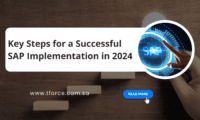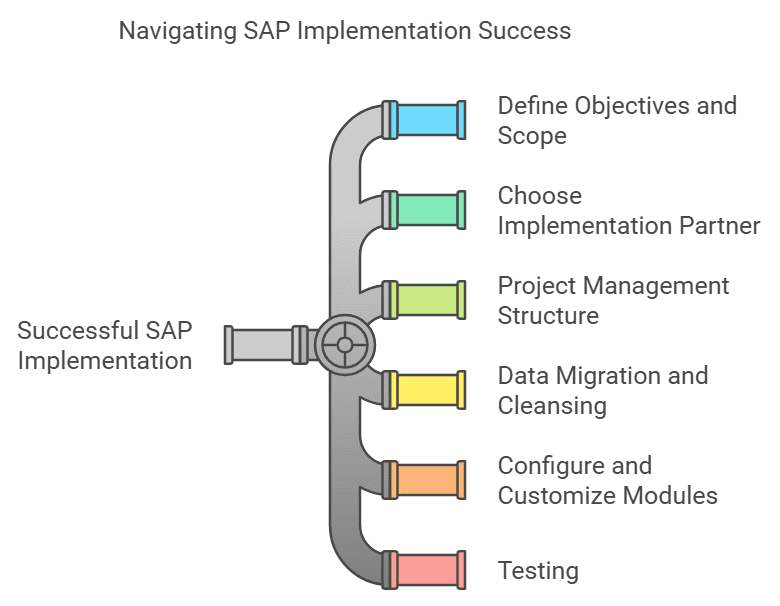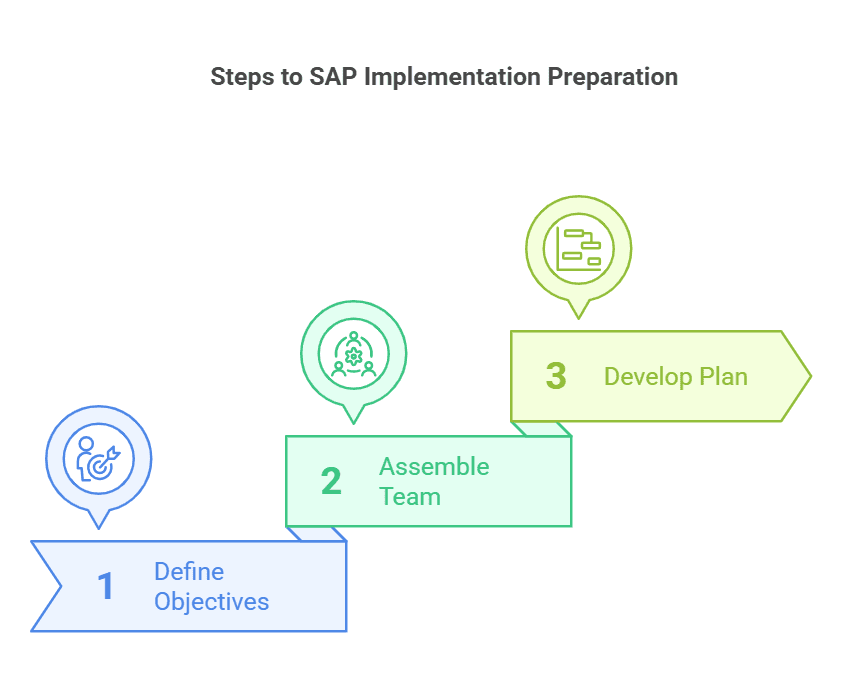
الخطوات الرئيسية لدليل تنفيذ SAP الناجح في عام 2025
يمكن أن يكون تطبيق SAP تحويليًا بالنسبة للمؤسسات التي تهدف إلى تعزيز عملياتها التجارية وزيادة الكفاءة ودفع عجلة النمو. ومع ذلك، فإن تحقيق النجاح تنفيذ SAP يتطلب تخطيطًا دقيقًا وتنفيذًا استراتيجيًا وفهمًا للخطوات الرئيسية التي تتماشى مع أفضل الممارسات في المجال. في هذا الدليل، سنرشدك في هذا الدليل إلى كل خطوة أساسية لتنفيذ SAP بسلاسة في عام 2024. هذا تنفيذ SAP سيكون الدليل مفيدًا بشكل خاص للشركات الجديدة على SAP أو تلك التي تتطلع إلى تحسين عملية نشر SAP الخاصة بها.
مقدمة في خدمات تنفيذ SAP دليل تنفيذ SAP
خدمات تنفيذ SAP مصممة لمساعدة المؤسسات في نشر برمجيات SAP، وتخصيصها وفقًا لاحتياجات العمل المحددة، ودمجها في بيئة تكنولوجيا المعلومات الحالية. من خلال استخدام عملية نشر SAP المُنظَّمة، يمكن للشركات تقليل الاضطرابات إلى أدنى حد ممكن وتعظيم إمكانات البرنامج لتبسيط العمليات. في هذه المدونة، سوف نلقي نظرة على كل مرحلة من المراحل الحرجة لضمان تنفيذ SAP بشكل ناجح وسلس.

1. تحديد أهداف ونطاق واضحين
يبدأ التنفيذ الناجح لنظام SAP بمجموعة محددة جيدًا من الأهداف. ويمكن أن يؤدي وضوح ما تريد تحقيقه من نظام SAP إلى توجيه عملية النشر بأكملها.
- أمثلة على الأهداف: تحسين إدارة سلسلة التوريد، أو تحسين التقارير المالية، أو تبسيط إدارة الموارد البشرية.
- إدارة النطاق: التأكد من أن النطاق واقعي ويمكن التحكم فيه، حيث يمكن أن يؤدي زحف النطاق إلى زيادة التكاليف وإطالة الجداول الزمنية.
الجدول: قائمة مراجعة الأهداف والنطاق
| الهدف | الوصف |
| تحسينات الكفاءة | تقليل العمل اليدوي وأتمتة المهام |
| رؤية معززة للبيانات | تحسين التقارير والتحليلات من أجل اتخاذ قرارات أفضل |
| قابلية التوسع | إعداد النظام للتوسع المستقبلي |
إعداد المشروع
Objective: Lay the groundwork for the SAP implementation by defining project goals, assembling the project team, and establishing a clear project plan.
Key Activities:
- Define Project Objectives: Clearly articulate what the organization aims to achieve with the SAP implementation, such as improving operational efficiency or enhancing data analytics capabilities.
- Assemble Project Team: Form a cross-functional team comprising IT professionals, business analysts, and key stakeholders to ensure diverse perspectives and expertise.
- Develop Project Plan: Create a detailed plan outlining timelines, resources, budget, and risk management strategies.
Practical Example: A manufacturing company aiming to reduce production downtime assembles a team of IT experts and production managers to plan the SAP implementation, focusing on integrating real-time monitoring systems.

2. اختر شريك تنفيذ SAP المناسب
يُعد اختيار شريك تنفيذ SAP المناسب أمرًا بالغ الأهمية لضمان سلاسة عملية نشر SAP. يجلب الشركاء ذوو الخبرة الخبرة والرؤى في هذا المجال، مما يساعد المؤسسات على تجنب العثرات الشائعة وضمان بقاء المشروع على المسار الصحيح.
- العوامل الرئيسية التي يجب مراعاتها:
- الخبرة: ابحث عن شريك يتمتع بسجل حافل في خدمات تنفيذ SAP.
- الخبرة في المجال: يمكن أن تساعد المعرفة الخاصة بالصناعة في تخصيص الحل.
- خدمات الدعم: دعم ما بعد النشر ضروري للنجاح على المدى الطويل.
مخطط الأعمال
Objective: Document detailed business processes and requirements to create a blueprint that will guide the SAP system configuration.
Key Activities:
- Conduct Workshops: Engage with various departments to gather requirements and understand current processes.
- Map Processes: Align existing business processes with SAP best practices and identify gaps.
- Develop Blueprint Document: Compile the findings into a comprehensive document that will serve as a reference during the implementation.
Practical Example: A retail company conducts workshops with inventory and sales teams to map out processes, identifying the need for real-time inventory tracking to prevent stockouts.
3. إنشاء هيكل قوي لإدارة المشروع
يعد إنشاء هيكل لإدارة المشروع أمرًا حيويًا لضمان المساءلة والتنفيذ السلس. وينبغي أن يحدد هذا الهيكل الأدوار والمسؤوليات، ويحدد المواعيد النهائية، ويحافظ على خطوط اتصال مفتوحة.
- مدير المشروع: الإشراف على الجدول الزمني للمشروع وميزانيته وموارده.
- القيادات الوظيفية: خبراء في وحدات محددة (مثل المالية واللوجستيات) لتوجيه التكوين.
- خطة التواصل: تحديثات منتظمة لأصحاب المصلحة حول التقدم المحرز في المشروع.
النقاط الرئيسية:
- تحديد الأدوار والمسؤوليات بوضوح.
- استخدم أدوات إدارة المشروع لتتبع التقدم المحرز.
- قم بإعداد اجتماعات منتظمة لمعالجة التحديات.
Objective: Configure the SAP system based on the business blueprint and develop necessary customizations.
Key Activities:
- Baseline Configuration: Set up core modules to reflect standard business processes.
- System Customization: Develop custom programs or reports to address unique business requirements.
- Integration Testing: Ensure that different modules and external systems work seamlessly together.
Practical Example: A financial services firm customizes the SAP Financial Accounting module to comply with local regulatory reporting standards.
4. ترحيل البيانات وتنقيتها
يُعد ترحيل البيانات أحد أكثر الجوانب صعوبة في عملية نشر نظام SAP. يجب على المؤسسات التأكد من أن البيانات دقيقة وذات صلة ومحدثة قبل الترحيل إلى نظام SAP.
- تنقية البيانات: إزالة البيانات القديمة أو الزائدة عن الحاجة أو الخاطئة.
- تخطيط البيانات: مواءمة هياكل البيانات في النظام القديم مع متطلبات SAP.
- الاختبار: إجراء اختبارات صارمة للتحقق من سلامة البيانات بعد الترحيل.
مثال على ذلك: يجب أن تضمن المؤسسة التي تقوم بترحيل بيانات عملائها إلى SAP S/4HANA أن تكون جميع تفاصيل الاتصال حديثة ومنسقة بدقة لتجنب حدوث مشكلات أثناء عملية التشغيل.
Objective: Prepare for the transition to the live SAP environment by conducting thorough testing, training end-users, and finalizing data migration.
Key Activities:
- User Acceptance Testing (UAT): Allow end-users to validate the system functionality against business requirements.
- End-User Training: Provide comprehensive training sessions to ensure users are comfortable with the new system.
- Data Migration: Cleanse and migrate data from legacy systems to the SAP environment.
Practical Example: A healthcare organization conducts UAT with medical staff to ensure the SAP system supports patient data management effectively.
5. تكوين وحدات SAP النمطية وتخصيصها
بمجرد إعداد البيانات، فإن الخطوة التالية هي تهيئة SAP وفقًا للمتطلبات الفريدة لمؤسستك. يتضمن ذلك تخصيص وحدات مختلفة لتناسب احتياجات العمل المحددة.
- وحدات SAP الأساسية:
- المحاسبة المالية (FI): إدارة البيانات المالية وإنشاء التقارير.
- إدارة المواد (MM): تحسين عمليات سلسلة التوريد.
- إدارة رأس المال البشري (HCM): تبسيط عمليات الموارد البشرية.
- التخصيص مقابل التوحيد القياسي: يمكن أن تضيف التخصيصات قيمة مضافة ولكنها قد تزيد من التعقيد والتكاليف. إن تحقيق التوازن هو المفتاح.
6. إجراء اختبارات صارمة
الاختبار أمر بالغ الأهمية للتأكد من أن النظام المهيأ يعمل كما هو متوقع. وينبغي أن يغطي الاختبار جميع السيناريوهات وسير العمل، بما في ذلك الحالات القصوى.
- اختبار الوحدة: اختبار المكونات الفردية.
- اختبار التكامل: التأكد من أن جميع الوحدات النمطية تعمل معًا بسلاسة.
- اختبار قبول المستخدم (UAT): مرحلة الاختبار النهائي حيث يقوم المستخدمون النهائيون بالتحقق من صحة الوظائف.
الجدول: أنواع الاختبارات
| نوع الاختبار | الغرض |
| اختبار الوحدة | التحقق من صحة الوحدات والوظائف الفردية |
| اختبار التكامل | اختبار التفاعل بين الوحدات |
| اختبار قبول المستخدم (UAT) | التأكد من أن النظام يلبي توقعات المستخدم |
7. تدريب المستخدمين النهائيين وتوفير الوثائق
يعتمد التنفيذ الناجح لنظام SAP بشكل كبير على قبول المستخدم. ويضمن تدريب المستخدمين النهائيين فهمهم لكيفية استخدام النظام الجديد بفعالية.
- الجلسات التدريبية: توفير دورات تدريبية عملية لكل وحدة نمطية.
- التوثيق: إنشاء أدلة إرشادية ومواد مرجعية سهلة الاستخدام.
- الدعم المستمر: توفير قنوات دعم للرد على استفسارات المستخدمين بعد بدء التشغيل.
مثال على ذلك: قد تحتاج المؤسسة التي تطبق نظام SAP للشؤون المالية إلى توفير التدريب لفرق الشؤون المالية على استخدام نظام SAP FICO.
8. بدء التشغيل ومراقبة الأداء
مرحلة التشغيل هي عندما يكون نظام SAP قيد التشغيل الكامل. وخلال هذه المرحلة، تكون المراقبة المستمرة ضرورية لتحديد المشاكل وحلها بسرعة.
- دعم هايبر كير: يجب أن يكون هناك فريق متخصص متاح لمعالجة أي مشاكل بعد بدء التشغيل.
- مراقبة الأداء: تتبع أداء النظام لضمان استيفائه للمعايير المتوقعة.
- مجموعة الملاحظات: جمع ملاحظات المستخدمين لتحديد مجالات التحسين.
Objective: Transition to the SAP system for daily operations and provide ongoing support to address any issues that arise post-implementation.
Key Activities:
- System Monitoring: Continuously monitor system performance to ensure stability.
- Issue Resolution: Establish a support team to address user-reported issues promptly.
- Continuous Improvement: Gather feedback to identify areas for system enhancement.
Practical Example: A logistics company monitors the SAP system post-go-live to ensure real-time shipment tracking is functioning correctly and addresses any discrepancies immediately.
By meticulously navigating each phase of the SAP implementation process, organizations can achieve a seamless transition to a robust ERP system that enhances efficiency and supports business growth.
9. التحسين والتحديثات المستمرة
إن تنفيذ SAP ليس عملية لمرة واحدة؛ فهو يتطلب تحسينات وتحديثات مستمرة لمواكبة احتياجات العمل المتطورة.
- التحديثات المنتظمة: تُصدر SAP تحديثات بشكل متكرر، ومن الضروري تنفيذ هذه التحديثات لتحسين الوظائف والأمان.
- تحسين العمليات: تحديد المجالات التي يمكن فيها تحسين نظام SAP بشكل أكبر لتحقيق مكاسب في الكفاءة.
- ابق على اطلاع: مواكبة خارطة طريق SAP واتجاهات الصناعة.
الخاتمة
يتطلب تحقيق تطبيق ناجح لنظام SAP في عام 2024 نهجًا منظمًا، حيث تساهم كل خطوة في عملية نشر SAP بسلاسة. من تحديد أهداف واضحة إلى توفير تدريب المستخدمين، يمكن أن تساعد هذه الخطوات المؤسسات على تعظيم فوائد نظام SAP الخاص بها. من خلال الاستفادة من خدمات تنفيذ SAP، واختيار الشريك المناسب، وضمان إدارة قوية للمشروع، يمكن للشركات أن تدفع النمو المستدام وتظل قادرة على المنافسة. سواء كنت متبنٍ جديد أو تقوم بترقية نظامك الحالي، فإن اتباع دليل تنفيذ SAP هذا سيُحدث فرقًا كبيرًا في النتيجة.
جدول ملخص: الخطوات الرئيسية لدليل تنفيذ SAP
| الخطوة | الوصف |
| تحديد الأهداف والنطاق | وضع أهداف واضحة ونطاق يمكن التحكم فيه |
| اختر شريك التنفيذ | اختر شريكاً متمرساً وذا خبرة في هذا المجال |
| هيكل إدارة المشروع | تحديد الأدوار والمسؤوليات وقنوات الاتصال |
| ترحيل البيانات وتنقيتها | إعداد بيانات دقيقة وذات صلة بالترحيل |
| تكوين الوحدات النمطية وتخصيصها | تكييف وحدات SAP لتلبية متطلبات العمل |
| الاختبار | التحقق من صحة الوظائف من خلال مراحل اختبار متعددة |
| تدريب المستخدمين النهائيين | التأكد من فهم المستخدمين لكيفية تشغيل النظام |
| بدء التشغيل والمراقبة | تشغيل النظام وتقديم الدعم الفوري |
| التحسين المستمر | تحديثات وتحسينات منتظمة لتحقيق النجاح المستدام |
توفر كل خطوة من هذه الخطوات أساسًا لتطبيق قوي وناجح لنظام SAP، مما يساعد المؤسسات على الاستفادة من إمكانات SAP الكاملة لتعزيز الكفاءة ودعم النمو.


